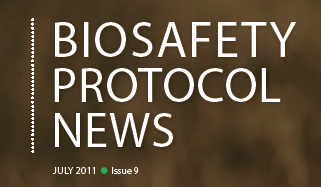The July 2011 issue presents experiences and lessons on national administrative systems for biosafety from Cuba, the EU, Kenya, Malaysia and Mexico.
The introduction to the issue, from CBD Executive Secretary Ahmed Djoghlaf, notes the importance of national administrative systems for the effective implementation of the Cartagena Protocol on Biosafety, especially regarding the import, release, and safety of living modified organisms (LMOs).
 July 2011: The ninth issue of “Biosafety Protocol News,” a magazine published by the Secretariat of the Convention on Biological Diversity (CBD), focuses on national administrative systems for biosafety. Contributions to the issue outline experiences and lessons learned from Africa, Asia, the EU, and Latin America and the Caribbean.
July 2011: The ninth issue of “Biosafety Protocol News,” a magazine published by the Secretariat of the Convention on Biological Diversity (CBD), focuses on national administrative systems for biosafety. Contributions to the issue outline experiences and lessons learned from Africa, Asia, the EU, and Latin America and the Caribbean.
In his introduction to the July 2011 issue, CBD Executive Secretary Ahmed Djoghlaf notes that national administrative systems for biosafety are cornerstones for the effective implementation of the Cartagena Protocol on Biosafety, since they provide mechanisms and procedures for handling applications and facilitating decision making regarding the import or release of living modified organisms (LMOs). Furthermore, such systems provide the mechanisms for monitoring and enforcement to ensure LMOs’ safety once they are approved.
The experiences and lessons described in the publication showcase the diversity of national administrative systems. While some countries have established centralized systems with a single designated institution for handling applications, coordinating public input and providing administrative support for risk assessment and decision making, others have placed administrative responsibility for biosafety in various government departments, depending on the type or intended use of the LMOs in question.
All of the systems presented include: multidisciplinary advisory bodies, to provide independent scientific and technical advice to the decision makers and risk managers; mechanisms for public access to information and stakeholder consultation, to foster transparency and public confidence in the decision-making process; and mechanisms for coordination and exchange of information between relevant regulatory agencies.
The experiences and lessons discussed come from Cuba, the EU, Kenya, Malaysia and Mexico. The publication also lists recent and upcoming biosafety meetings. [Publication: Biosafety Protocol News, Issue 9]